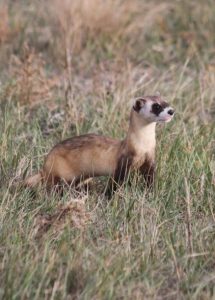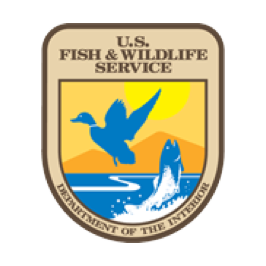Standing Rock Tribe, USFWS release endangered ferrets on Reservation

Director Jeff Kelly (center), Standing Rock Game & Fish receives black-footed ferret picture from Ms. Lauren Toivonen, John Hughes (far left) USFWS, also with Waylon Little Eagle and Thomas DeLong (Game & Fish Rangers) and Drew Becker, USFWS, far right (Courtesy Photo).
McIntosh, South Dakota – Wednesday, October 20, 2021, Standing Rock Sioux Tribe Game & Fish Department collaborating with the United States Fish and Wildlife Service (USFWS) released 28 ferrets on their reservation in the state of South Dakota.
The Standing Rock Sioux Tribe located in North and South Dakota under the direction of Jeff Kelly, Director of the tribal Game & Fish Department. USFWS collaborated with the department, to release ferrets in acceptable habitats on the South Dakota portion of the reservation, south of McIntosh SD, where expansive prairie dog towns meet the suitable living requirements for black-footed ferret, the most endangered mammal in the United States.
The black-footed ferret, Mustela nigripes, is a small to medium-sized carnivore. Female black-footed ferrets range in weight from 645–850 grams The fur of Mustela nigripes is yellowish-buff with pale under parts. The forehead, muzzle and throat are white, and the feet are black. A black mask is observed around the eyes, which is well defined in young black-footed ferrets. It is the only ferret species native to the Americas, and there are no recognized subspecies.

Seth Gutzmer, tribal biologist for Standing Rock, stands next to the carriers of ferrets before their release into the wild on Standing Rock Reservation in October 2021.
Twenty-eight ferrets (16 male and 12 female) arrived from the National Black-footed Ferret Conservation Center in Carr, CO, via wildlife biologist John Hughes. They left the NBFFCC at 5am on the day-of.
In October 2012, Gutzmer’ firm New Century Environmental (NCE), the tribal biologist for Standing Rock, first documented the most endangered mammal in North America, the black-footed ferret (Mustela nigripes), on Standing Rock Indian Reservation in North and South Dakota, south of the Grand River near Mobridge. NCE has supported Standing Rock Indian Reservation for almost 10 years.
Earlier this year, New Century Environmental (NCE) secured a grant in getting Standing Rock Game & Fish Department from the Bureau of Indian Affairs to document wild ferrets on the reservation to assess presence and abundance of possible impacts to ESA-listed species like northern long-eared bats (listed as Threatened 4(d)) and black-footed ferrets (listed as ESA Endangered).

The first ferret released on Standing Rock south of McIntosh on the proposed Black-footed Ferret Recovery Area, Courtesy photo- Michael P. Gutzmer 2021
At present, known ferret populations exist only at reintroduction sites where introduced populations remain small, fragmented, and intensively managed with only a few of these introduced populations producing wild-born adults. As a result of the bottleneck of the captive breeding program, black-footed ferrets have lost 90% of their genetic diversity.
The long term goal for the tribe is to maintain control for black-tailed prairie dogs in an area primarily used for cattle grazing and the Service goals are to eventually save the ferret from extinction, expanding the ferret’ range into this part of South Dakota. A long term management plan has been written to effectively maintain their sustainability on the reservation.
Article by Dr. Micheal Gutzmer, Standing Rock Sioux Tribe Wildlife Biologist






